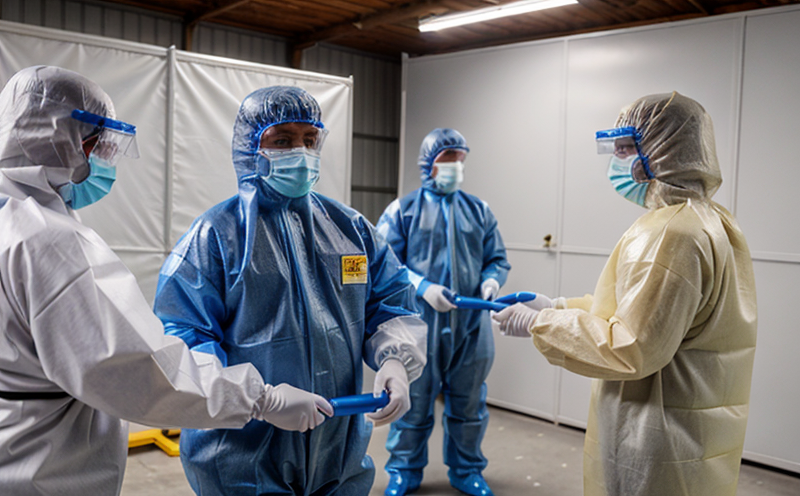ISO 6529 Chemical Suits Resistance to Permeation by Liquids and Gases
The ISO 6529 standard specifies methods for determining the resistance of chemical protective clothing, such as gloves, overalls, aprons, and other similar garments, against permeation by liquids or gases. This service ensures that workers are adequately protected from hazardous chemicals in industrial environments.
Protective clothing is a critical component in safety protocols to prevent occupational exposure to harmful substances. The standard applies primarily to chemical protective clothing used in industries such as petrochemicals, pharmaceuticals, and manufacturing where workers might come into contact with corrosive materials or toxic vapors.
The testing procedure involves exposing the protective garment to various liquids or gases that simulate real-world conditions of exposure. Specimens are prepared according to the standard's specifications, which may include washing the material before testing if it has been previously used. The test involves placing a known quantity of the chemical on one side of the fabric and measuring any permeation through the material over time.
The ISO 6529 method is designed for liquids with viscosities similar to water, but modifications can be made for other viscosities by adjusting parameters such as the flow rate. The standard also provides guidance on how to select appropriate chemicals for testing based on their potential risk in the workplace.
During the permeation test, a series of measurements are taken at regular intervals to determine the rate of chemical penetration through the fabric. These measurements are critical in assessing the barrier properties of the garment and ensuring it meets regulatory requirements for occupational health and safety.
The results of these tests provide valuable data for quality managers and compliance officers responsible for maintaining safe working environments. The findings can help identify areas where improvements might be needed, such as selecting more robust materials or adjusting personal protective equipment policies.
R&D engineers benefit greatly from this service by gaining insights into the performance characteristics of different fabrics under various exposure conditions. This information is essential for developing new products that offer enhanced protection against chemical hazards.
For procurement teams, ISO 6529 compliance ensures that they are procuring appropriate protective clothing that meets industry standards and protects workers effectively. By adhering to this standard, organizations demonstrate their commitment to employee safety and regulatory compliance.
Benefits
The implementation of the ISO 6529 standard brings numerous advantages to businesses operating in high-risk chemical environments:
- Enhanced worker safety: By ensuring that protective clothing meets stringent permeation resistance standards, workers are better protected from hazardous chemicals.
- Regulatory compliance: Adhering to international standards like ISO 6529 helps organizations comply with local and global regulations governing occupational health and safety.
- Informed decision-making: The detailed test reports generated from this service provide valuable data for quality management, R&D, and procurement teams. This information supports informed decisions regarding product specifications and supplier selection.
- Continuous improvement: Regular testing ensures that protective clothing remains effective over time, allowing businesses to make necessary adjustments to maintain optimal safety standards.
- Purchasing confidence: Suppliers can verify the performance of their products through this standardized testing process, boosting consumer trust and satisfaction.
In summary, ISO 6529 chemical suits resistance to permeation by liquids and gases is a crucial service that enhances workplace safety while ensuring compliance with international standards. Its application across various sectors demonstrates its importance in maintaining high levels of occupational health and safety.
International Acceptance and Recognition
The ISO 6529 standard has gained widespread acceptance and recognition globally, making it a cornerstone for chemical protective clothing testing:
- Global adoption: This standard is widely adopted by industries in countries across the world, including Europe, North America, and Asia. Its universal applicability ensures consistency in testing methods and results.
- Interoperability: Compliance with ISO 6529 facilitates interoperability between different manufacturers and suppliers, promoting a harmonized approach to chemical protective clothing design and production.
- Standardization: By adhering to this standard, businesses can ensure that their products meet the highest international standards, thereby enhancing their reputation in the global market.
- Consistency: The standardized testing procedures outlined in ISO 6529 provide consistent results across different laboratories and facilities, allowing for accurate comparisons and assessments of protective clothing performance.
The standard's acceptance by regulatory bodies around the world further emphasizes its significance. Many countries incorporate compliance with ISO standards into their national regulations, ensuring that businesses operating within these jurisdictions adhere to internationally recognized safety benchmarks.
Environmental and Sustainability Contributions
Incorporating ISO 6529 chemical suits resistance testing contributes significantly to environmental sustainability efforts:
- Resource efficiency: By ensuring that protective clothing is effective in preventing chemical leaks, the standard helps minimize waste by reducing the need for frequent replacements of ineffective garments.
- Hazardous waste reduction: Effective protection reduces the amount of hazardous materials entering the environment through accidental spills or breaches in containment systems.
- Eco-friendly manufacturing: The standard encourages manufacturers to use sustainable and recyclable materials, promoting a greener production process. This approach not only enhances environmental sustainability but also aligns with growing consumer demand for eco-friendly products.
- Energy efficiency: Enhanced barrier properties of protective clothing can lead to reduced energy consumption in manufacturing processes by minimizing the need for additional layers or reinforcements.
The ISO 6529 standard plays a vital role in fostering environmental responsibility within industries that rely heavily on chemical protective clothing. By focusing on performance and durability, this service helps promote a more sustainable approach to occupational health and safety practices.





